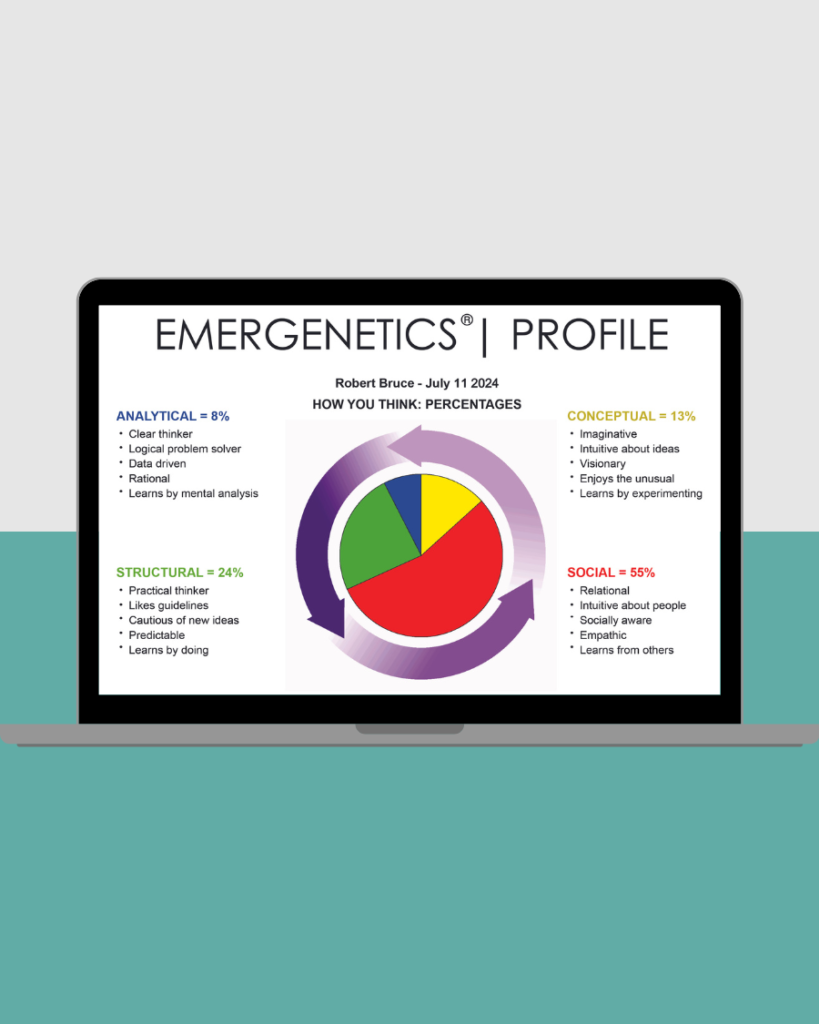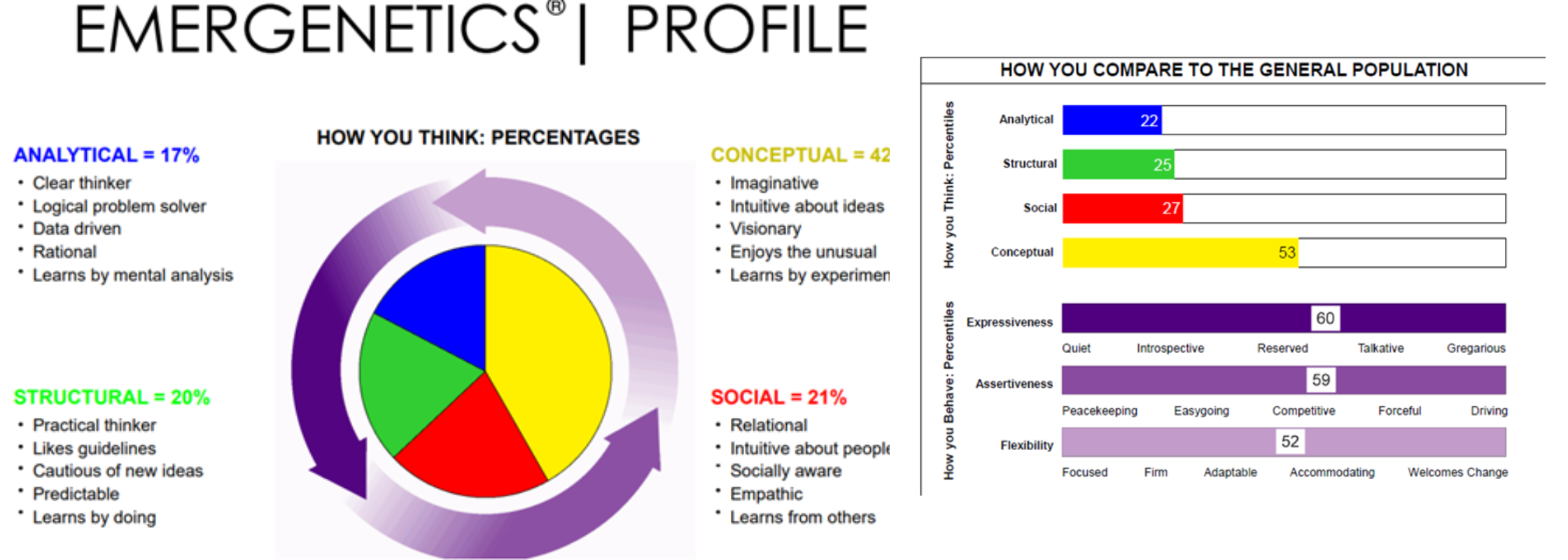
Agile vs Chaotic Leadership: Navigating the fine line between adaptability and disorder
In today’s rapidly changing business environment, leaders are increasingly expected to be agile. But agility, when misunderstood or misapplied, can easily drift into chaos.
We see this a lot when running Emergenetics® workshops.
One of the criteria that Emergenetics measures is Flexibility.
You can see in many workplaces this has become a loaded word: Job descriptions value agility and flexibility so those with a lower “score” on this measure are looked upon as barriers to progress.
Yet as we’re always at pains to point out: Teams need disruptors to challenge conventional thinking – at the same time as they need individuals with focus who ensure delivery.
No surprise, it’s a balance of skills and approaches that builds winning teams.
Understanding Agile Leadership:
Agile leadership is characterised by flexibility, responsiveness, and a commitment to learning. Rooted in the principles of Agile methodologies (originating from software development), it emphasises:
- Customer focus
- Empowered teams
- Iterative improvement
- Adaptability in the face of change
- Flexible, established systems
According to McKinsey & Company (2021), agile leaders promote clarity of purpose, psychological safety, and distributed authority. They balance the tension between stability and dynamism by creating systems that are resilient but responsive.
Chaotic Leadership – The agility impostor:
Chaos often masquerades as agility and at first glance it’s not easy to spot the difference between the two.
This creates a performance trap for leaders who inadvertently confuse action with progress. Chaotic leaders are likely to operate with real pace, but you might see:
- Constantly shifting priorities
- Poor communication and lack of follow-through
- Fragmented roles and blurred responsibilities
- Lack of strategic guardrails
- Adhoc ways of working
This unpredictability leads to disempowered teams, frequent rework, and organisational fatigue.
In the long run it’s a management style very likely to result in burnout, misaligned initiatives, and decision-making bottlenecks.
Research from Harvard Business Review found that leaders who operate without clear frameworks can create environments perceived as unpredictable and stressful—even when aiming for innovation.
The cost of this can be huge – for you, your people and your business goals.
The impact on teams:
Agile leadership tends to increase engagement and psychological safety. Studies by Amy Edmondson and others demonstrate that teams led with agility are more likely to innovate and adapt without fear of retribution.
Conversely, chaotic leadership undermines team trust. Unclear goals, shifting expectations, and disordered workflows can lead to learned helplessness.
Teams that should be celebrating new client acquisition instead dread this news as they brace themselves for the ensuing chaos.
R&D teams learn that what’s needed today will be discarded tomorrow…All of which then fuels their leader’s drive for yet more chaotic change as they seek to fix the very problem they’re creating.
You can’t scale chaos:
This is one of the biggest constraints coming out of chaotic leadership.
An organisation’s ability to scale up and sustain growth is deeply influenced by its prevailing leadership style.
Agile leadership creates the foundations for scalable growth by embedding repeatable systems, nurturing a culture of learning and accountability, and aligning teams around purpose-driven outcomes.
This structure enables rapid innovation and customer responsiveness without sacrificing cohesion.
In contrast, chaotic leadership undermines scalability. Its lack of clarity, shifting priorities, and over-reliance on reactive decision-making leads to resource misalignment, fragmented execution, and strategic drift.
As the organisation grows, these cracks widen, resulting in stalled momentum, talent loss, and operational fatigue.
Simply put, agility fuels sustainable growth; chaos chokes it.
“Agile is not about speed—it’s about speed in the right direction.”

The leader’s experience:
You could take a selfish perspective on this and ask: What impact does my approach have on me?
After all, looking after yourself is one of the most important jobs any leader needs to tackle.
It’s really clear that leaders are not immune to the consequences of their own approach.
Whether leading with agility or defaulting into chaos, the ripple effects touch not just their performance, but also their mental and physical wellbeing.
The Agile Leader: Grounded, strategic, sustainable
Leaders who embrace true agility operate with a sense of clarity, purpose, and alignment. Because they build structured systems, delegate effectively, and use feedback loops, they avoid becoming the bottleneck in decision-making.
And this shows up as:
- Greater confidence and control: Operating with clear priorities and repeatable habits reduces overwhelm
- Cognitive clarity: Systems thinking reduces decision fatigue
- Improved wellbeing: Clarity of roles and distributed ownership support better sleep, reduced stress, and more time for strategic thinking
- Enhanced credibility: Trust from teams and peers grows when consistency and transparency are visible
“When leaders work on the system instead of getting caught in the system, they lead more effectively and sustainably.”
– Peter Senge, The Fifth Discipline
The Chaotic Leader: Overwhelmed, isolated, exhausted
Chaotic leaders, while often passionate, energetic and well-meaning, frequently find themselves in a perpetual firefighting state. They carry the weight of constant decision-making, unclear priorities, and a lack of structure.
And the price that’s paid is:
- Decision fatigue and mental overload due to lack of clarity or delegation
- Chronic stress and burnout from being “always on”
- Reduced personal credibility when teams experience inconsistency or disorganisation
- Isolation and disempowerment as teams disengage or lose trust
- Increased risk of emotional exhaustion
“You can’t pour from an empty cup. Structured agility lets leaders give without depletion.”
Making Agile Leadership a way of life:
By now you might be asking: What steps can I take to become an Agile Leader?
And Agility comes from this positive mindset. But more than that, it needs systems that make responsiveness repeatable and scalable. Doing this involves:
1. Consistent communication
- Daily standups, weekly reviews, monthly retrospectives
2. Frameworks for decision-making
- Use RACI models (Responsible, Accountable, Consulted, Informed)
- Define decision-rights at all levels to decentralise authority
3. Strategic guardrails
- OKRs (Objectives and Key Results) provide focus and flexibility
- Align short term sprint goals to strategic objectives to avoid “random acts of agility”
4. Feedback and learning loops
- Embed customer and employee feedback into reviews
- Encourage safe-to-fail experiments supported by structured review
5. Role clarity and cross-functional teams
- Define team roles clearly to avoid duplication or blind spots
- Promote T-shaped skills for adaptability (Balancing deep expertise and broad knowledge)
6. Technology enablement
- Use agile-supportive and AI tools (e.g. Trello, Jira, Miro) to visualise work and enhance transparency
- Automate reporting and systems to free up brains for insightful decision-making
Final thoughts
The really important take-out is that you can’t sacrifice pace. If your customers value responsiveness and a quick turnaround then that’s what you’ll deliver for them.
Agile leadership is about doing this in a way that’s constantly learning; building people and approaches that grow over time. It’s a disciplined response to complexity.
Chaos, in contrast, is agility without direction.
The difference lies not in pace or innovation, but in making your response to it purposeful and structured.
If you’d like to explore how you can develop the leadership style you want your team to see – then get in touch with us for an introductory chat.
